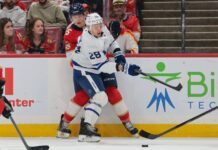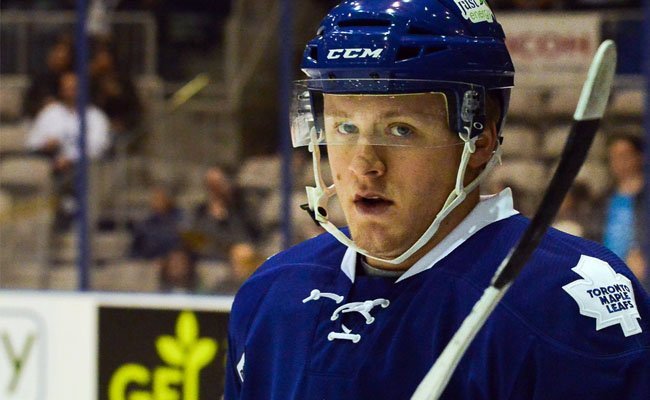Bear with me and read through this. I know it is a topic that has been beaten to death, but I would like to add another perspective.
Some of you have probably noticed that my Twitter feed and recent postings have had some form of hockey analytics mentioned. A part of that reason is that I wanted to share a different perspective on my feed as well as chronicling my growing interest in the puck possession trend. But the main reason is because I have finally filtered out the negative personalities behind some of the metrics and focused more on the measures being used.
It is no secret that at the puck possession level, the Toronto Maple Leafs have been a frustrating example of a team that rope-a-dopes throughout the game, often spending too much time in their own end trying to regain the puck rather than actually producing offense. Which is kind of the conundrum – the Leafs are an offensive powerhouse, having finished 10th and 6th overall in goals per game in the last two seasons, without actually putting a lot of pucks on net and being soundly outshout almost every game.
Hockey doesn’t really glorify statistics the way football and baseball do. The sport idealizes certain numbers like 50 in 50 or the hat-trick, but until recently, hockey hasn’t really found a way to measure time of possession. I remember when I played the EA’s NHL series on the XBox 360, there would be a post-game analysis that showed exactly how long I had the puck. I always found that number fascinating because I would often get frustrated by how often I DID NOT have the puck. Which is part of the grand theme here – I wanted to improve my possession time because it meant that I was getting better at the game and that the opposition would have less of a chance of scoring those stupid goals I stood no chance of defending.
The discussion and analysis of possession isn’t exactly new to hockey vernacular either. Many of you know of the Edmonton Oilers’ 1980s dominance – a lot of ink was used to describe their game, often referring to their ability to possess the puck for minutes on end, frustrating their opponents. As hockey expanded into the 1990s, the Detroit Red Wings took over as the league’s most dominant hockey team – their puck possession was often highlighted as one of the core reasons for their success.
In fact, going back to 2003, well before the advent of Corsi and Fenwick, I found an article that aptly explains just how the Red Wing teams dominated their opponents:
At a time when defenses still are strangling offenses on a daily basis, the Red Wings are playing an Edmonton Oilers, circa 1980s, puck possession style of game. Although time of possession is not an NHL statistic, the Red Wings are presumed to be the league leader. They fly with the puck about the ice, back and forth, like they are doing yo-yo tricks.
“It’s an awful difficult game to play, and here we have four lines who can play the same way,” Schneider says. “You don’t have two lines who can do it and two others who just fire it in and try to get it back.”
Schneider says Los Angeles coach Andy Murray “was as open a coach as anyone” in terms of wanting his defensemen to jump into the offensive flow. However, since joining the Red Wings, Schneider is carrying the puck more now than he ever did. Detroit general manager Ken Holland says the team’s puck possession really dates to 1996, when coach Scotty Bowman pushed for and acquired Slava Fetisov and Larionov and put together the Russian Five that also included Vladimir Konstantinov, Fedorov and Slava Kozlov.
“I think the rest of our guys practiced with these guys and watched these guys hang onto the puck and hang onto the puck, and pretty soon even our checkers got to the point where they could cycle the puck and hang onto it,” Holland says. “That’s just our game … a lot of guys have been playing it since 1996.”
You see, hockey isn’t just about scoring goals. It’s about preventing them too. Owning the puck is one of many ways to prevent goals, and quite possibly the best way to do so. When you have the puck, the other team cannot score. Just as much as I love watching a Leafs player stiff arm his opponent trying to drive through the boards, I love to see my own team take advantage of their puck skills to play keep-away or make a pretty pass.
Of course, that’s not all. Now that Corsi has had several years to accumulate data and tweak its statistical merits, there’s more statistical development coming along. @mc79hockey actually went through a lot of trouble to find a way to quantify the value of a faceoff by using the time after a faceoff to determine a winning or losing influence on a shot attempt. A happy coincidence because we happen to have a pretty polarizing centre playing on the first line in Tyler Bozak. The link above positively quantifies Bozak’s faceoff value, but of course, it would be nice to have him finish off a brilliant Phil Kessel pass more often than not.
Coincidentally, I was reading up on faceoffs a while ago and found an article from 2002 that I have been saving specifically for a post like this one. This article goes into great detail of using Yanic Perreault as an example of the value of faceoffs. At the very least, faceoffs are a valuable commodity – something that Bozak should be getting more credit for, especially given the scarcity of the Leafs offensive zone faceoffs in recent seasons.
In addition, there’s another metric being tracked called zone entry. This is actually a fascinating question and answer session from Eric T. of Broadstreet Hockey detailing the many benefits of tracking zone entries:
• How involved is he in gaining the zone: if the team enters the zone with him on the ice, what are the odds he’s the one sending it in?
• How successful is he at gaining the zone: when he brings the puck in, how often does he carry it to possession rather than dump and chase?
• How good is he with the puck in the offensive zone: when he carries the puck in, how many shots does the team get?
• How good is he off the puck in the neutral zone: what is the team’s carry-in percentage when he’s on the ice?
• How good is he off the puck in the offensive zone: how many shots per carry-in does the team get when he’s on the ice?
• How good is he at puck retrieval: how many shots per dump-in does the team get when he’s on the ice?
• How good is his neutral zone defense: what is the opponent’s carry-in percentage when he’s on the ice?
• How good is his defensive zone defense: how many shots per carry-in do the opponents get when he’s on the ice?
Overall, the main point of this article is that as much as we love to hate those who run around on social media insulting anyone who disagrees with their approach, there’s a lot to like and a lot to gain from having a statistical outlook on the sport’s possession influence. I am not trying to convert anyone here. But I do want to see people become more open-minded about the real promise possession proxies have in hockey – there is no disadvantage in following the evolution of statistics in sports. However, I do understand where @Burtonboy12 was coming from when he said he just wants to be able to watch hockey without drowning the entertainment in numbers that don’t always reflect the outcome.
On Morgan Rielly:
Yesterday, we got an article from Pierre Lebrun that quoted a Western scout suggesting that he had nothing more than second pairing upside. Not so fast, Mr. Vancouver scout. Rielly’s performance last night showed exactly why he was drafted fifth overall.
Once Rielly got the first period nerves out of the way, when he had the puck on his stick, he was making more positive things happen than negative ones. There was one play in the second period where he had two forecheckers barreling towards him on the left side of the boards, little time to make a play, and actually fired a precise pass to a breaking Leafs forward across the ice that resulted in an odd-man rush. The breakout skill is badly needed on this team.
In addition, we saw at least three breakouts on Rielly’s part that all resulted in a scoring chance. He gained the zone with ease and highlighted promising distribution ability on the point. I think he’s here to stay. It’s only been one game, but if the offense is at the NHL level, the only way Rielly will learn defense at the NHL level is to stay with the team.
Great win last night. Here’s hoping the boys go for four in a row on Tuesday.














![John Gruden after the Leafs prospects’ 4-1 win over Montreal: “[Vyacheslav Peksa] looked really comfortable in the net… We wouldn’t have won without him” John Gruden, head coach of the Toronto Marlies](https://mapleleafshotstove.com/wp-content/uploads/2025/09/gruden-post-game-sep-14-218x150.jpg)




















